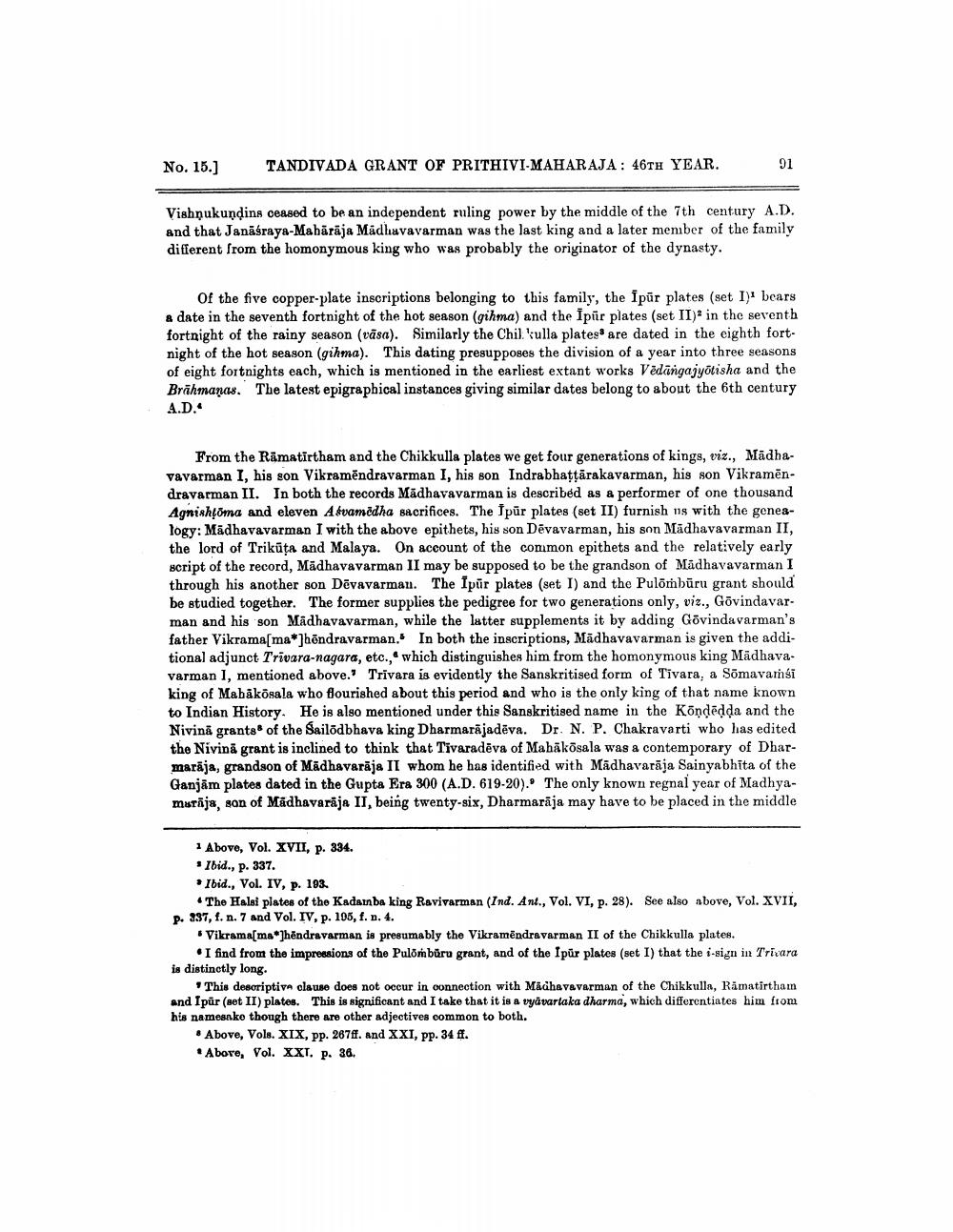________________
No. 15.]
TANDIVADA GRANT OF PRITHIVI-MAHARAJA : 46TH YEAR.
91
Vishņukundins ceased to be an independent ruling power by the middle of the 7th century A.D. and that Janäsraya-Maharija Madhavavarman was the last king and a later member of the family different from the homonymous king who was probably the originator of the dynasty.
Of the five copper-plate inscriptions belonging to this family, the Ipār plates (set 1): bears a date in the seventh fortnight of the hot season (gihma) and the Ipār plates (set II) in the seventh fortnight of the rainy season (vāsa). Similarly the Chilkulla plates are dated in the eighth fortnight of the hot season (gihma). This dating presupposes the division of a year into three seasons of eight fortnights each, which is mentioned in the earliest extant works Vēdāngajyotisha and the Brāhmanas. The latest epigraphical instances giving similar dates belong to about the 6th century A.D.
From the Rämatirtham and the Chikkulla plates we get four generations of kings, viz., Madhavavarman I, his son Vikramēndravarman I, his son Indrabhattārakavarman, his son Vikramēndravarman II. In both the records Madhavavarman is described as a performer of one thousand Agnish(oma and eleven Afvamedha sacrifices. The pur plates (set II) furnish 19 with the geneslogy: Madhavavarman I with the above epithets, his son Dēvavarman, his son Madhavavarman II, the lord of Trikūta and Malaya. On account of the common epithets and the relatively early script of the record, Madhavavarman II may be supposed to be the grandson of Madhavavarman I through his another son Dēvavarman. The Ipur plates (set I) and the Pulombūru grant should be studied together. The former supplies the pedigree for two generations only, viz., Govindavarman and his son Madhavavarman, while the latter supplements it by adding Govinda varman's father Vikrama[ma*]höndravarman. In both the inscriptions, Mādhavavarman is given the additional adjunct Trivara-nagara, etc., which distinguishes him from the homonymous king Madhavavarman 1, mentioned above.' Trivara is evidently the Sanskritised form of Tivara, a Sõmavamsi king of Mabākosala who flourished about this period and who is the only king of that name known to Indian History. He is also mentioned under this Sanskritised name in the Kõndēdda and the Nivină grants of the Sailodbhava king Dharmarājadēva. Dr. N. P. Chakravarti who has edited the Niviná grant is inclined to think that Tivaradēva of Mahäkosala was a contemporary of Dharmarāja, grandson of Madhavarāja II whom he has identified with Madhavarāja Sainyabhita of the Ganjām plates dated in the Gupta Era 300 (A.D. 619-20). The only known regnal year of Madhyamarāja, son of Madhavarāja II, being twenty-six, Dharmarāja may have to be placed in the middle
1 Abovo, Vol. XVII, p. 334. * Ibid., p. 337. • Ibid., Vol. IV, p. 193.
• The Halsi plates of the Kadanba king Ravivarman (Ind. Ant., Vol. VI, p. 28). See also above, Vol. XVII, p. 237, f. n. 7 and Vol. IV, p. 105, f. n. 4.
*Vikrama[ma*]hēndravarman is presumably the Vikramēndravarman II of the Chikkulla plates.
I find from the impressions of the Pulornbüro grant, and of the Ipur plates (set I) that the i-sign in Trivara is distinctly long.
This desoriptiva clauso does not occur in connection with Madhavavarman of the Chikkulla, Ramatirtham and Ipur (set II) plates. This is significant and I take that it is a vyävarlaka dharma, which differentiates him from his namesake though there are other adjectives common to both.
. Above, Vols. XIX, pp. 267ff. and XXI, pp. 34 ff. *Abore, Vol. XXT. p. 36.




